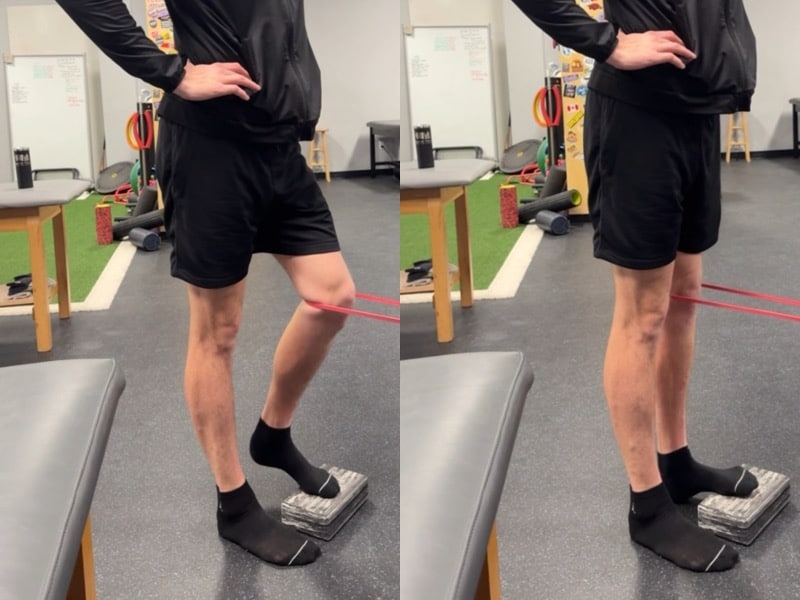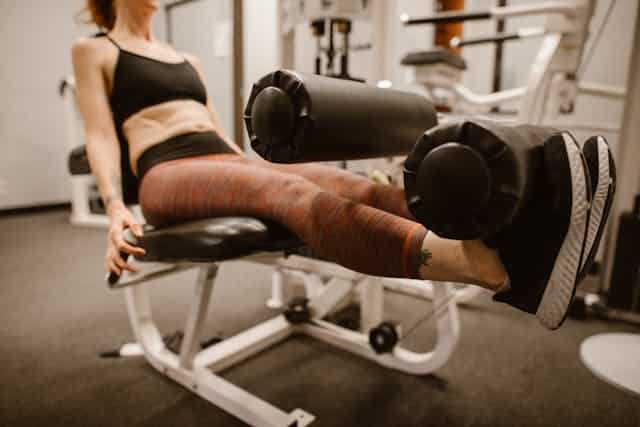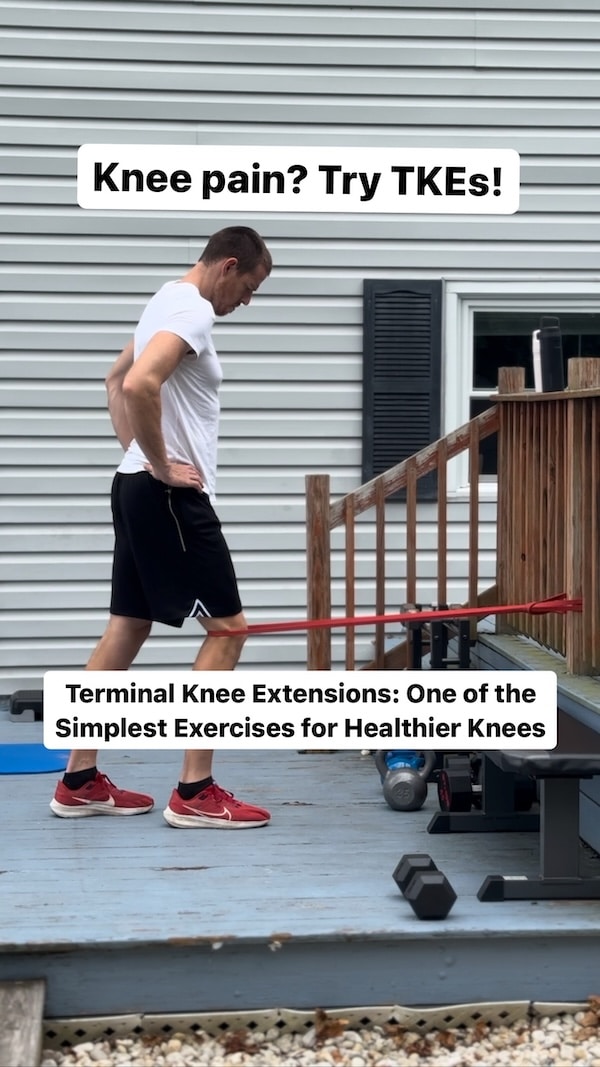Terminal Knee Extensions: TKE Exercise Benefits, How to Do
The Terminal Knee Extension, or TKE, is a powerful exercise for knee health.
As a 6’10” professional basketball player, I use the TKE exercise to keep my knees strong and injury-free.
Given the physical demands of my career, incorporating terminal knee extensions into my routine is crucial for preventing injuries and ensuring peak performance.
Additionally, I have my wife, who has had arthritis since she was young, do this exercise to help manage her condition.
Our team physiotherapist or athletic trainer also frequently prescribes terminal knee extensions to players dealing with jumper’s knee or other common knee issues, and my experiences have shown me that this is one of the best exercises for knee pain.
What is the Terminal Knee Extension Exercise?
The study by Richard Dontigny (1972) presents terminal knee extension (TKE) exercises as a series of strengthening and therapeutic movements targeting the final phase of knee extension.
These exercises collectively focus on building or restoring full range of motion in the knee and strengthening the quadriceps, particularly the vastus medialis oblique (VMO), which plays a key role in stabilizing the patella during knee extension.
While Dontigny’s work does not single out specific positions, terminal knee extension exercises generally include variations that can be performed seated, lying down, or standing.
The standing, banded TKE exercise, which this article focuses on, utilize a resistance band anchored at knee level, allowing the individual to push back against the band in a standing position.
This terminal knee extension variation engages the muscles through the entire knee extension range, fostering functional strength and stability necessary for activities like walking, running, and squatting
Terminal Knee Extensions Muscles Worked
Through its combination of muscle engagement, terminal knee extensions contribute to lower-body strength, improved knee tracking, and enhanced stability, making it a beneficial exercise for daily activities and athletic performance.
Quadriceps
The TKE exercise is one of best quadriceps exercises, specifically the VMO.
- The VMO is crucial for stabilizing the patella (kneecap) and ensuring proper knee tracking during movements.
- Strengthening this muscle helps prevent common knee issues, such as patellar maltracking, which can lead to discomfort or injury.
Hamstrings
- The hamstrings play a stabilizing role by controlling knee extension and helping prevent excessive forward movement of the tibia.
- This counteraction improves knee stability, especially during weight-bearing exercises.
Gluteal Muscles
- Specifically, the gluteus medius and other gluteal muscles support hip alignment, which is critical for lateral stability and knee alignment.
- Engaging the glutes helps control hip position, reducing strain on the knee joint.
How to Do the Banded TKE Exercise
Although there are several terminal knee extension variations that require different setups, the execution of the exercise largely remains the same. Here is a step-by-step guide for how to do the standing, banded TKE exercise:
- Set Up: Attach a resistance band to a sturdy anchor point at knee height. Loop the other end around the back of your knee.
- Starting Position: Stand facing the anchor point with the resistance band behind your knee. Your back leg should remain stiff and straight, while the forward knee is slightly bent.
- Execution: Slowly extend your forward knee, allowing it to track out over your toes. Focus on fully contracting your quadriceps and straightening your knee completely. Keep your back leg straight throughout the movement.
- Return: Slowly return to the starting position, maintaining control and tension in the resistance band.
Safety Tips
Incorporating the TKE exercise into your routine can significantly enhance knee health, improve stability, and prevent injuries.
Whether you are an athlete looking to optimize performance or someone recovering from a knee injury, the TKE exercise offers a versatile and effective solution for maintaining healthy knees.
These tips will help ensure safety while doing TKEs:
- Knee Tracking: Ensure your forward knee tracks out over your toes. This motion is essential for proper knee mechanics and preventing injury.
- Back Leg Stability: Keep your back leg stiff and straight throughout the exercise. Only the forward knee should bend and extend, isolating the movement to target the appropriate muscles.
- Control: Perform the exercise slowly and with control. Avoid using momentum, as this can reduce the effectiveness of the exercise and increase the risk of injury.
Benefits of the Terminal Knee Extension Exercise

Knee health is essential for maintaining mobility, preventing injuries, and optimizing performance in both everyday activities and sports.
Terminal Knee Extensions (TKEs) are a powerful tool for strengthening the knee joint, enhancing stability, and improving functional movement.
By specifically targeting the vastus medialis oblique (VMO) and other key stabilizing muscles, TKE exercises help refine patellar tracking, reinforce knee alignment, and build strength in the quadriceps, hamstrings, and glutes.
Improves Patellar Tracking
The patella, or kneecap, relies on precise alignment within the femoral trochlear groove to function correctly during knee extension and flexion.
Terminal Knee Extension (TKE) exercises specifically activate the vastus medialis oblique (VMO), a medial quadriceps muscle crucial for stabilizing the patella and preventing lateral displacement.
Weakness or delayed activation of the VMO can contribute to patellar maltracking, which leads to increased stress on the patellofemoral joint and conditions such as patellofemoral pain syndrome (PFPS).
By strengthening the VMO, TKE exercises enhance neuromuscular control over the patella, ensuring smoother movement and reducing excessive lateral pull from the vastus lateralis.
Develops Knee Stability
Knee stability depends on the coordination of multiple muscle groups that control the tibiofemoral joint.
TKE exercises strengthen the quadriceps, particularly the distal fibers responsible for controlling terminal knee extension, while also engaging the hamstrings and gluteal muscles.
The hamstrings play a key role in decelerating knee extension and preventing anterior tibial translation, reducing strain on the anterior cruciate ligament (ACL).
Additionally, the gluteus medius and maximus contribute to hip and pelvic stability, minimizing valgus collapse—a common risk factor for ACL injuries and patellar maltracking.
This comprehensive muscular engagement improves knee stability during weight-bearing movements, reducing excessive joint stress and promoting safer mechanics.
Increases Functional Strength
TKE exercises target the final degrees of knee extension, a range critical for producing force efficiently in daily activities and sports.
The quadriceps, particularly the rectus femoris and vastus medialis, are responsible for generating terminal extension force, which is essential for movements such as rising from a chair, walking, stair climbing, and maintaining posture.
For athletes, strong quadriceps ensure more powerful knee extension during explosive actions like sprinting, jumping, and rapid directional changes.
Additionally, reinforcing the end range of motion in knee extension prevents compensatory movement patterns that can increase injury risk in both athletic and non-athletic populations.
Supports Injury Prevention and Rehabilitation
TKE exercises are commonly prescribed in rehabilitation protocols for knee injuries, particularly those involving ligamentous and meniscal damage.
Strengthening the quadriceps and surrounding stabilizers helps offload stress from passive structures such as the ACL and meniscus, which are vulnerable to shear forces during high-impact movements.
Additionally, by improving joint proprioception and neuromuscular control, TKE exercises facilitate smoother force distribution across the knee, reducing abnormal loading patterns that contribute to chronic injuries.
Individuals recovering from ACL reconstruction, patellar tendinopathy, meniscal repair, or knee osteoarthritis often benefit from controlled TKE movements that restore strength and full knee extension without excessive joint compression.
Improves Balance and Proprioception
Proprioception, or the body’s ability to sense joint position and movement, is a key factor in maintaining dynamic stability.
TKE exercises challenge neuromuscular coordination by requiring controlled knee extension against resistance, which stimulates mechanoreceptors in the knee joint, ligaments, and surrounding musculature.
This heightened proprioceptive feedback improves reflexive stabilization and joint awareness, reducing the risk of falls or misalignment under load.
Advanced variations, such as single-leg TKEs or performing terminal knee extensions on unstable surfaces (e.g., balance pads), further enhance proprioceptive adaptation by engaging the deep stabilizing muscles of the lower limb, reinforcing control during unpredictable movements like sudden stops or directional changes in sports.
Progressions & Advanced TKE Exercise Variations
Progressing terminal knee extension (TKE) exercises is essential for developing balanced knee strength and enhancing functional stability.
Progressions and variations in TKE exercises keep the movements effective by preventing plateaus and strengthening all muscle fibers supporting knee stability.
These adaptations enhance knee function, especially for daily activities and athletic endeavors, by building a solid foundation of muscular and neuromuscular control.
Here are a few additional tips:
- Control the Tempo: Slowing down the extension phase in TKEs can further challenge the muscles and help prevent compensations.
- Integrate Unstable Surfaces: Using tools like balance pads can increase the proprioceptive demand on the knee joint, making it suitable for injury prevention training.
- Alternate Leg and Resistance Work: Alternating between light resistance for endurance and heavy resistance for strength promotes balanced knee musculature, vital for long-term joint health.
Now, here are several ways to progress TKEs and advanced variations that target different aspects of knee strength, stability, and endurance.
Stronger Bands
Using a thicker resistance band adds intensity to standing, banded TKE exercises.
This increased resistance challenges the quadriceps more and requires greater control from stabilizing muscles, especially in the hips and core, to maintain proper alignment.
Progression through resistance levels helps ensure that the knee adapts to greater loads, an approach aligned with overload principles in rehabilitation and strength conditioning.
More Repetitions and Sets
Gradually increasing the volume of TKE exercises can improve endurance and muscle coordination around the knee.
Starting with 2-3 sets of 10-15 repetitions is common; however, adding repetitions or sets (up to 4 sets of 20) encourages further muscular endurance without overwhelming the joint, making it ideal for rehabilitative and stability-focused goals.
Increased repetitions also help activate the vastus medialis, crucial for knee stabilization.
Seated Leg Extensions

Seated leg extensions, often done on a machine, isolate the quadriceps. While this movement primarily focuses on the quadriceps, its positioning allows for greater range control, especially useful for building strength after injury.
To simulate a TKE, adjust the range to target the last 15-30 degrees of extension, which reinforces control over terminal knee movement.
Though less functional than standing, seated leg extensions provide excellent control over the load, reducing compensatory movements common in standing variations.
Mini-Band Bench Leg Extensions
The mini-band leg extension is performed sitting on a bench with a looped resistance band around both ankles, challenging each leg individually.
By extending one leg against the band’s resistance, this exercise targets the quadriceps in a way that emphasizes knee extension without full-body stabilization.
It’s a versatile way to isolate the knee joint, helping develop targeted strength in the quadriceps without loading the knee or hip excessively.
Single-Leg TKE with Band
For an advanced stability challenge, try performing TKE exercises on one leg. In this version, the band is placed around the knee as in the regular TKE, but the non-working leg hovers off the ground.
This version not only strengthens the quadriceps and the knee stabilizers but also requires intense balance and core activation.
It’s highly functional for athletes or those seeking to improve proprioception and control during dynamic activities.
Split Squat TKE
Split Squat TKEs are an advanced variation that integrates the resistance of a terminal knee extension into a split squat position.
In this version, a resistance band is anchored behind the front knee, pulling it into slight flexion as you descend.
As you rise from the bottom of the split squat, the quadriceps—particularly the vastus medialis oblique (VMO)—must actively extend the knee against band tension, reinforcing proper knee tracking and full extension.
This movement not only increases load on the working leg but also enhances hip-knee-ankle alignment, proprioceptive control, and functional strength through a dynamic, weight-bearing range of motion.
It’s especially useful for athletes and individuals progressing from basic TKEs toward more sport-specific or performance-based knee strengthening.
Final Thoughts: Are Terminal Knee Extensions a Good Exercise?
Terminal Knee Extensions (TKEs) are one of the most effective exercises for strengthening the knee, improving joint stability, and preventing injuries.
Whether you are an athlete looking to enhance lower-body function, a fitness enthusiast aiming to reinforce knee health, or someone recovering from an injury, TKEs offer a simple yet highly effective way to build strength in the quadriceps—particularly the vastus medialis oblique (VMO)—and improve overall knee mechanics.
Beyond injury prevention, TKEs help restore proper patellar tracking, enhance proprioception, and support functional movement patterns necessary for walking, squatting, jumping, and running.
Their versatility allows them to be incorporated into rehabilitation programs, strength training routines, and athletic performance workouts.
By adjusting resistance, volume, and stability factors, TKEs can be tailored to suit any fitness level or rehabilitation need.
For those experiencing knee discomfort or recovering from surgery, TKEs provide a low-impact method to restore full knee extension and strengthen supporting muscles without excessive joint stress.
However, proper execution is key to maximizing benefits and preventing compensation patterns.
When performed with control and precision, TKEs are a valuable addition to any knee-focused training regimen, supporting long-term joint health and movement efficiency.
Frequently Asked Questions About Terminal Knee Extensions (TKEs)
Should I feel knee pain while doing TKEs?
No. You should feel muscular engagement, especially in the front of the thigh (quadriceps), but not sharp or pinching pain in the knee. If pain occurs, adjust band tension, check your form, or consult a physiotherapist to rule out compensatory movement patterns.
Read Next: How to Fix Jumper’s Knee



